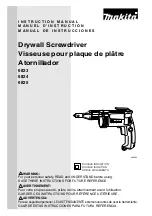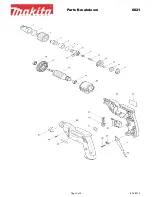
MaximalFEV Expandable Power Systems
- 5 -
MaximalFEV Installation Instructions:
Wiring methods shall be in accordance with the National Electrical Code/NFPA 70/ANSI, the Canadian
Electric Code, Part I, Part II, and with all local codes and authorities having jurisdiction .
Product is intended for indoor use only .
Power Supply Board Terminal Identification
(pg. 6)
Power Supply Stand-by Battery Specifications
(pg. 6)
Power Supply Board LED Diagnostics
(pg. 7)
Power Supply Board Output Voltage Settings
(pg. 7)
1 . Mount unit in desired location . Mark and predrill holes in the wall to line up with the top three keyholes in
the enclosure . Install three upper fasteners and screws in the wall with the screw heads protruding . Place
the enclosure’s upper keyholes over the three upper screws; level and secure . Mark the position of the
lower three holes . Remove the enclosure . Drill the lower holes and install the three fasteners . Place the
enclosure’s upper keyholes over the three upper screws . Install the three lower screws and make sure to
tighten all screws (Enclosure Dimensions, pg. 11) .
2 . Connect unswitched AC power (220VAC 50/60Hz) to terminals marked [L, N] (Fig. 2, pg. 8) .
Use 14 AWG for larger for all power connections . Secure green wire lead to earth ground lug .
Keep power-limited wiring separate from non power-limited wiring.
Minimum 0.25” spacing must be provided.
CAUTION: Do not touch exposed metal parts.
Shut branch circuit power before installing or servicing equipment.
There are no user serviceable parts inside. Refer installation and servicing to qualified service personnel.
3 . Select desired DC output voltage by setting SW1 to the appropriate position, (Maximal11FEV, Maximal13FEV,
Maximal33FEV, Maximal35FEV and Maximal37FEV) (Fig. 1a, pg. 7). Maximal55FEV power supplies are
factory set at 12VDC . Maximal77FEV power supplies are factory set at 24VDC . Maximal75FEV power
supplies are factory set at 12VDC and 24VDC (Power Supply Board Stand-by Battery Specifications, pg. 6).
4 . Measure output voltage before connecting devices . This helps avoiding potential damage .
5 . Connect devices or Altronix sub-assembly modules to be powered to the terminals marked [– DC +]
(Fig. 2, pg. 8) . For auxiliary device connection, this output will not be affected by Low Power Disconnect
or Fire Alarm Interface . Connect device to the terminals marked [+ AUX –] (Fig. 2, pg. 8).
Refer to page 3 for non power-limited applications.
6 . For Access Control applications batteries are optional . When batteries are not used, a loss of AC will result
in the loss of output voltage . When the use of stand-by batteries is desired, they must be lead acid or gel type .
Connect battery to the terminals marked [– BAT + ] (Fig. 2, pg. 8) . Use two (2) 12VDC batteries connected
in series for 24VDC operation (battery leads included) . Use batteries - Casil CL1270 (12V/7AH), CL12120
(12V/12AH), CL12400 (12V/40AH), CL12650 (12V/65AH) batteries or UL recognized BAZR2 batteries of
an appropriate rating .
7 . Connect appropriate signaling notification devices to AC FAIL & BAT FAIL (Fig. 2, pg. 8) supervisory
relay outputs .
8 . To delay AC reporting for 2 hrs ., set DIP switch [AC Delay] to OFF position (Fig. 2, pg. 8) .
To delay AC reporting for 1 min ., set DIP switch [AC Delay] to ON position (Fig. 2, pg. 8) .
Note: Must be set to ON position for Burglar Alarm Applications .
9 . To enable Fire Alarm Disconnect set DIP switch [Shutdown] to ON position . (Fig. 2, pg. 8) .
To disable Fire Alarm Disconnect set DIP switch [Shutdown] to OFF position . (Fig. 2, pg. 8) .
10 . Trigger terminals are end of a line resistor supervised (10k Ohms) . Opening or shorting trigger terminals
will cause [DC] output to shutdown (Fig. 2, pg. 8) .
11 . Place a jumper for non-latching FACP . A momentary short on these terminals resets FACP latching
[Trigger EOL Shutdown] (Fig. 2, pg. 8) .
12 . For Access Control Applications: mount UL Listed tamper switch (Honeywell Model 112 or equivalent) at
the top of the enclosure . Slide tamper switch bracket onto the edge or the enclosure approx . 2” from the
right side (Fig. 2a, pg. 8) . Connect tamper switch wiring to the Access Control Panel input or the appropriate
UL Listed reporting device .
13 . Please ensure that the cover is secured with the provided key lock .
Maintenance:
Unit should be tested at least once a year for the proper operation as follows:
Output Voltage Test: Under normal load conditions the DC output voltage should be checked for proper
voltage level (MaximalFEV Configuration Chart, pg. 4).
Battery Test:
Under normal load conditions check that the battery is fully charged, check specified
voltage at the battery terminals and at the board terminals marked [– BAT +] to
ensure that there is no break in the battery connection wires .
Note:
Maximum charge current 1 .54A .
Expected battery life is 5 years; however, it is recommended to change batteries within 4 years or less if necessary .
Содержание Maximal11FE
Страница 10: ...10 MaximalFEV Expandable Power Systems Notes...






























